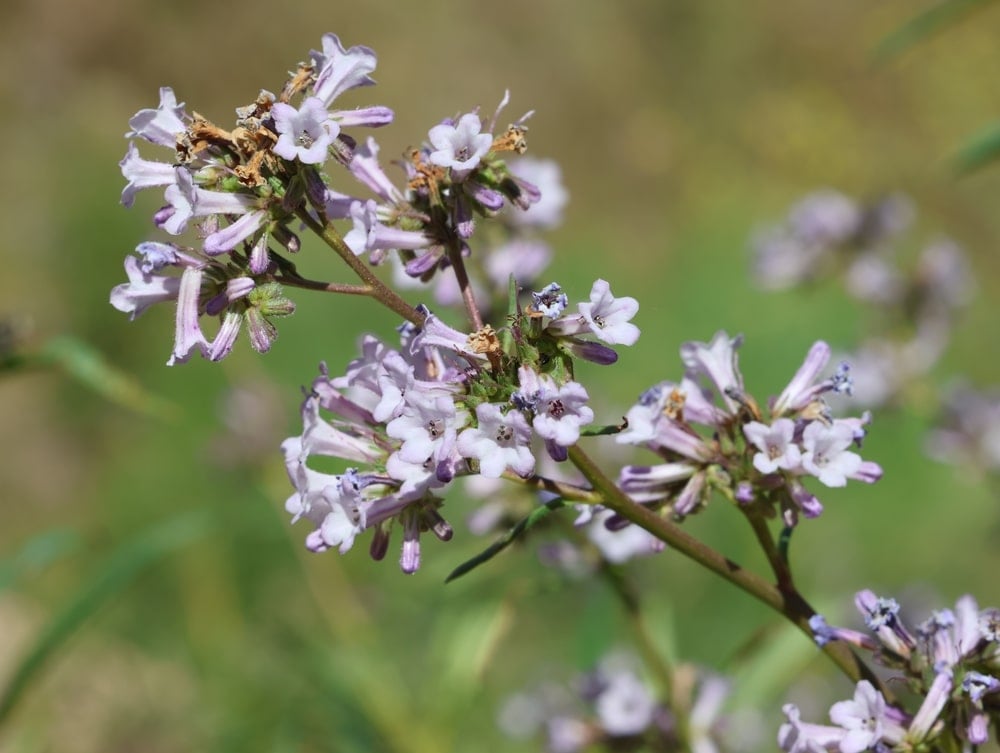
Yerba Santa flower, known scientifically as Eriodictyon californicum, is a remarkable evergreen shrub native to California and parts of the southwestern United States, including northern Mexico and Oregon. Also referred to by various common names such as sacred herb, holy herb, mountain balm, gum plant, bear’s weed, gum bush, and consumptive weed, this plant holds a significant place both ecologically and medicinally.
Description and Appearance
Yerba Santa is an erect, woody shrub that can grow up to 6 to 8 feet tall, often forming dense clusters or scattered stands in its native habitats. Its leathery, sticky leaves are coated with aromatic resin, giving them a shiny, varnished appearance. The leaves have serrated margins and a lighter green underside with prominent veins, sometimes covered with fine hairs forming a “hairy net.” The yerba santa flower is bell-shaped, typically white to pale purple with purple anthers and paired styles, blooming from spring through summer. Bees and butterflies are attracted to these flowers, playing a vital role in the plant’s pollination.
Taxonomy and Family
Yerba Santa belongs to the borage family (Boraginaceae), a group known for its distinctive scorpion-like inflorescence and bell-shaped flowers. Some botanists previously classified it under the waterleaf family (Hydrophyllaceae), now considered a subfamily within Boraginaceae. The genus Eriodictyon includes other species native to the southwestern United States, each adapted to different ecological niches.
Habitat and Distribution
This aromatic shrub thrives in chaparral, oak woodlands, and disturbed soils, especially areas recovering from fire, where its seeds germinate readily. Yerba Santa is native to California, southern Oregon, northern Mexico, and the broader Pacific West region. Its ability to grow on dry, rocky soils and disturbed land makes it an important species for land stabilization and ecological restoration.
Medicinal Uses and Traditional Healing
Yerba Santa has been used for centuries by Native American tribes, including the Miwok, Pomo, Yuki, Yurok, and Chumash, as a powerful medicinal plant. It is renowned for treating respiratory ailments such as asthma, colds, and bronchitis, acting as a natural decongestant and expectorant. The resinous leaves can be brewed into yerba santa tea or used in steam inhalations to relieve congestion and soothe irritated mucous membranes. Additionally, poultices made from the leaves have been applied to wounds to reduce swelling and aid healing.
Preparation and Recipes
Yerba santa tea is prepared by steeping dried leaves and flowers in boiling water for 10 to 20 minutes, often sweetened with honey to balance its bittersweet, resinous flavor. The leaves can also be infused into syrups or honeys, creating soothing remedies for coughs and allergies. Some traditional recipes even incorporate yerba santa into chocolates and ice creams, showcasing the plant’s unique aromatic qualities.
Cultivation and Harvesting
Cultivating yerba santa in gardens requires well-drained soil and a sunny location, mimicking its native dry habitats. The plant is drought-tolerant and can be grown from seeds or cuttings. Harvesting is best done in spring when the leaves are fresh and aromatic, taking care to gather sustainably to protect wild populations. Leaves should be dried separately to prevent clumping due to their sticky resin.
Ecological and Cultural Significance
Beyond its medicinal properties, yerba santa plays a vital ecological role by providing habitat and food for native pollinators and stabilizing soils in fire-affected landscapes. Its cultural importance as a sacred herb is reflected in its Spanish name, which means “holy herb,” acknowledging the reverence held by indigenous peoples and early settlers alike.
Conclusion
Yerba Santa flower, Eriodictyon californicum, is a versatile and valuable plant native to California and the southwestern United States. Its distinctive bell-shaped flowers, aromatic sticky leaves, and powerful medicinal qualities make it a treasured member of the borage family. Whether used in traditional healing, garden cultivation, or ecological restoration, yerba santa continues to be a symbol of natural resilience and sacred heritage.
References
- Moore, M. Medicinal Plants of the Pacific West. Museum of New Mexico Press, Santa Fe, 1993.
- Funk, A., & Kaufman, K. Living Wild: Gardening, Cooking and Healing with Native Plants of California. Flicker Press, Nevada City, CA, 2013.
- Slatterly, J. “Sonoran Plant Profile: Yerba Santa.” Blog post, 2016. https://www.haalo.org/tips-for-harvesting-yerba-santa/
- Kloos, S. “Yerba Santa Holy Herb.” Blog post, 2017. https://scents-of-earth.com/yerba-santa-united-states/
- Wikipedia contributors. “Eriodictyon californicum.” Wikipedia, The Free Encyclopedia. https://en.wikipedia.org/wiki/Eriodictyon_californicum
- Green, J. Medicine Making: The Essential Guide. Chelsea Green Publishing, 2014.
- Corelli, T. Flowering Plants of Edgewood Natural Preserve. Edgewood Natural Preserve Publications.
Masterful Display
Each and everyone of our products are deeply considered, labored over, and improved upon time and time again. We invite you to experience the difference of our carefully crafted small batches of herbal support items. Whether it be our tea line, produced for a delightful experience, or our tincture blends and extracts, we have what you need.

